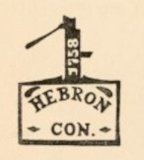
The Hebron Historical Society
Hebron, Connecticut
Enjoy Hebron - It's Here To Stay ™

Hebron has lots of land identified as “Open Space”. These expanses can be found throughout the town. Some areas, such as Gay City, are owned by the State, but many are owned by the Town and are there for all to enjoy. The town-owned Open Spaces are resource protected and for passive recreational use. That means they should remain just as they were when purchased, other than for future trail marking.
Luckily for all of us, some of these spaces were not developable; they were steep, rocky, perhaps a bit wet, and not accessible by roads. They may have been old farms that were split by tracks when the Air Line RR went through. They may have been right next to a body of water where a dam and mill had been located. In whatever manner, the property had been well used and appreciated by our early settlers. When walking through these areas, one can relax, view the natural beauty all around, and imagine how life was lived “back when”. Take a look at the attached Open Space Map and see what’s available for your enjoyment.
In 1811, as can be found on a map, Hebron had many streams but very few roads. In its early days, Hebron made much use of its “brooks”. Over 30 historic water-powered mill sites have been found on Fawn and Raymond Brooks, the Blackledge and Jeremy Rivers, the water that flowed from Amston Lake (originally “North Pond”), and more. Take a walk in one of these public areas, and YOU, too, can discover an old mill site.
The Raymond Brook Preserve has a very interesting history. The area could be known as Settlers Park since Hebron’s first settler, William Shipman, from Saybrook, built his cabin there in 1704. The Shipman family was a direct recipient of land from the Will of Attawanhood, Sachem of the Western Nehantics. The Raymond Brook Preserve’s West, North and East boundaries follow, respectively, Church Street, Kinney Road, and Millstream Road with a connection from Millstream across to Holy Family Church.
In 1790 John Gilbert, who had previously acquired the settler’s property and more, sold his 144.5 acres to Erastus Perkins, who sold that same property in 1804 to Hebron’s Zechariah Cone. For $3,870, Cone then sold the 144.5 acres to Ira Bissell in 1839. The North part of the house, presently owned by the church, was already there when the Bissells acquired it. The Bissell family lived on and improved the property until 1914 when they sold some acreage to the Hildings, and the remaining 50 acres were bought by the Hortons in 1920. Interestingly, the corner lot at Church Street and Kinney Road had a “dwelling house” when it was bought by John Gilbert prior to 1786. The well from that early house remains today and serves the later 1850’s home on Kinney Road.
Frederic Phelps Bissell, who lived on the above property his entire life, kept journals from 1847-1905. From those journals, one can learn all about life in Hebron in the mid-19th century. F.P. Bissell comments on his daily and seasonal farm activities, his connection with St. Peter’s Church as Warden and Caretaker, his shingle, sorghum, and sawmills, participation in local politics and his time in Hartford as Hebron’s representative, the daily weather, as well as illnesses, deaths, and marriages of townspeople, and much more. A narrative written from the journals can be found on the Hebron Historical Society website (hebronhistoricalsociety.org) along with a larger map of Hebron’s “Open Space”, and also the town’s Water-Powered Mills map.
Exploring Hebron’s Open Space is a “Buy 1, Get 2 Free Deal”. You provide the energy for the walk and are rewarded with views of Hebron’s natural beauty as well as learning more about the Town’s History.